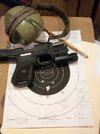Practicing under all conditions is the only way to identify gear and tools that do and don't work for you. And to determine what techniques you're good at, and which you need to work on.
Practice under all lighting conditions (dawn, dusk, day, night, natural and artificial lighting).
Practice under all concealment clothing you ever use. Wearing cold weather gear, rain gear, layers, open front/closed front, gloves both thick and thin. And under just a t-shirt.
Practice in the wind, when its calm, facing into the sun, with the sun at your back, with the sun high in the sky, and low on the horizon.
Practice seated, prone, supine, behind barriers of all heights, in addition to standing,
Some things I've learned and changed from practicing under all kinds of conditions:
1) Had Mrs. Luzyfuerza sew some pouches into the strong-side tail of open front shirts I like to wear as cover garments. I carry folders in these pouches. Keeps the shirts from blowing open in the wind.
2) Changed my cleaning routine when I found that shooting into the sun with a dusty RDS didn't work too well.
3) Instead of just imagining how it would be, I actually tried drawing quickly from the seated position while carrying IWB and in a pocket. I experienced first-hand that this really is difficult to impossible. Got off the dime and found a high-quality ankle holster that is all-day comfortable (
https://www.ritchieholsters.com/catalog/p-100011/ankle). Then practiced drawing from the ankle while in the seated position.
MUCH BETTER. Now, when I'm going to be behind the wheel for any length of time, I add a BUG in the ankle holster to supplement my IWB rig.
4) I can't tell you how many combinations of lumens and candela I've tried in handheld flashlights. Now, I have an indoor light (moderate lumens and broad throw) and an outdoor light (the most lumens I can find and tightly focused throw).
5) There's nothing like actually rolling around on the ground during practice to convince civilian gun carriers not to EDC that beautiful chromed revolver or that prized heirloom Colt 1911 in an alligator pancake holster. Every day is not a BBQ, I guess.
And so on, hundreds of times over.
None of these fixes will come as a surprise to anyone here. You know them. And I knew them. However, getting out and actually practicing under various conditions using my normal carry gear prodded me to implement them. And that's what matters.





